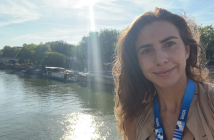The United States is in the throes of an opioid crisis. A recent report by the National Safety Council has revealed that it is statistically more likely for Americans to die from an opioid overdose than it is for them to die in a car crash. While everyone agrees that the ultimate goal is to save lives, legal professionals, policymakers, medical professionals, and community members do not always see eye to eye in terms of the most effective way to prevent opioid overdose deaths. These differences of opinion were manifest on Wednesday at a Fordham Law panel that explored the viability of supervised injection sites as a strategy to combat the crisis.
Community leader Terrell Jones spoke to the audience about the feelings of desolation and hopelessness that drug users experience due to society’s perceptions of them.
“Every time that you look around, they’re being dehumanized: by the media, by people in the their community,” said Jones, a former drug user who now works in outreach and advocacy for marginalized low-income persons who use drugs. “Individuals need a place that they come and feel that they’re wanted, feel like they’re needed, feel like their personal needs will be addressed.”
According to Jones, that place of support is the supervised injection site, also known as a supervised consumption site. These legally sanctioned sites allow individuals to consume pre-obtained drugs under the supervision of professional staff rather than using alone on the street. Supporters of the sites argue that overdose deaths are prevented due to the safety of the facility and the training of the staff. While there are more than 100 supervised consumption sites around the world, the United States currently has none.
Panelist Brandon del Pozo, chief of police in Burlington, Vermont, said the supervised sites may be effective in major cities with big municipal budgets, but in smaller communities like the one he polices, the sites would do little to stop opioid deaths.
“If we’re interested in solutions that serve vast swaths of America equally and devoting those resources in ways that are equitable, safe injection is not a good solution for rural drug use,” he said.
Del Pozo instead praised the life-saving benefits of buprenorphine, a medication used to treat opioid dependence and addiction. He gave examples of buprenorphine being distributed to drug-addicted persons in France, as well as in the Rhode Island prison system, and seeing their opioid overdose mortality reduce by 79% and 62% respectively.
“[Safe injection] would be one of the last things I would devote my resources to, because you cannot scale it up in a way that starts having a population-level effect on mortality reduction now, which is what we need,” he said.
Following del Pozo, moderator Serge Schmemann, New York Times journalist, turned to Philadelphia District Attorney Larry Krasner to ask him about a lawsuit recently filed by U.S. attorney William McSwain to try to stop the City of Brotherly Love from becoming home to the country’s first supervised consumption site.
“When you have crazy people in the federal government, and they put crazy people in charge of federal law enforcement, then you get crazy,” said Krasner, unafraid to air his opposition to the lawsuit and to show his support for supervised consumption. Krasner went on to talk about the importance of the supervised site in Vancouver, North America’s oldest such site, and how it allows individuals to seek help without feeling shame.
“The reality is that what is killing people who are suffering from an addiction to opioids is stigma,” said Krasner. “And the reason that they are taking the drugs is because they are a symptom of something else.”
Bridget Brennan, special narcotics prosecutor for New York City, expressed concern for what supervised consumption signals to the community.
“What are supervised injection sites? It’s the government saying it’s OK to shoot up. It’s the government saying in some way this is safe,” she said. “I don’t think that that is a message that is going to help us in terms of preventing people from falling into this horrible, horrible problem.”
Brennan stressed that she believes in prevention for a problem that she boiled down to the danger inherent in drugs. “There are no safe drugs out there on the street,” she said.
Kimberly Sue, M.D., medical director of the Harm Reduction Coalition, approached the issue from the perspective of a doctor doing everything she can to help prevent patient deaths.
“We have a medicine that is a miracle; it literally reverses overdoses,” she said, in reference to buprenorphine. “Wouldn’t you want me to be there in a place where I could take of my patient? Wouldn’t you want someone who is trained to reverse an overdose with compassion 24 hours a day in a safe clean space where we can enable people to live?”
“Dead people don’t recover,” Sue stressed.
The panelists also discussed various legal issues related to the opioid crisis, including the federal statute known as the crack house statute, which Krasner feared could be used to prosecute “idealistic, young medical students.”
The panel was organized by the School’s A2J Initiative, the Fordham Law student-run Drug Policy Reform Group (DPRG), the Opioid Center of Support, and the Justin A. Solak Foundation, which was founded by Fordham Law Assistant Dean Vera Bullock following the 2016 death of her son of an opioid overdose.
Prior to the panel, a memorial service was held for William Pickering Jones III, a Fordham Law student who died on Christmas Day in 2018, following his own battle with opioids. Jones, a member of DPRG, had been instrumental in putting together the panel. Among the friends and family members of Jones who spoke at the memorial was his father.
“I’m learning that in many cases Will was right—right on the human side of things. He was a good person,” William Jones II said of his son. “Good people make good institutions. Fordham Law School, we have learned, is full of good people. It was a good place for William.”




